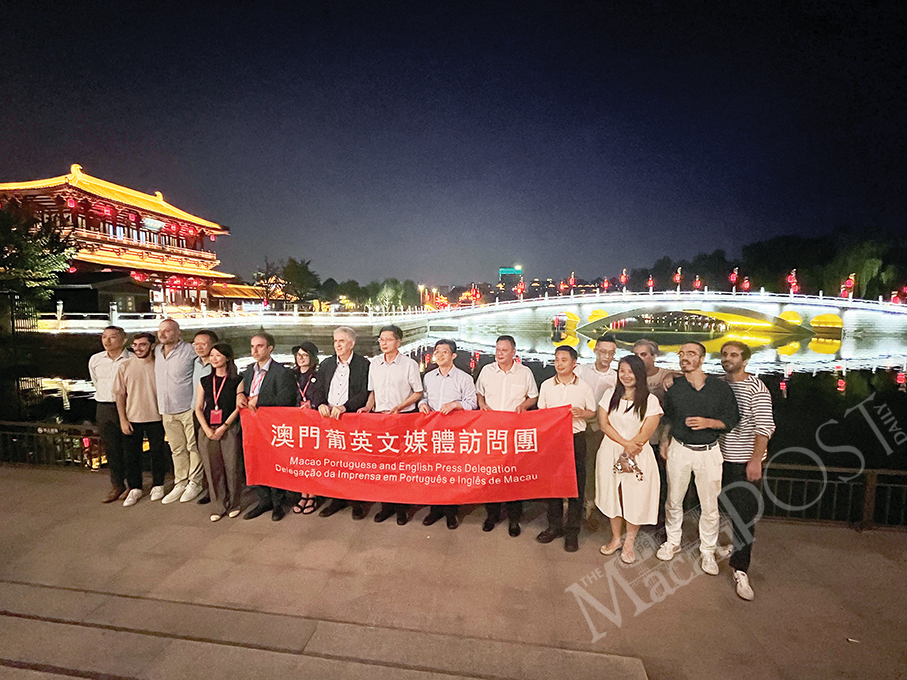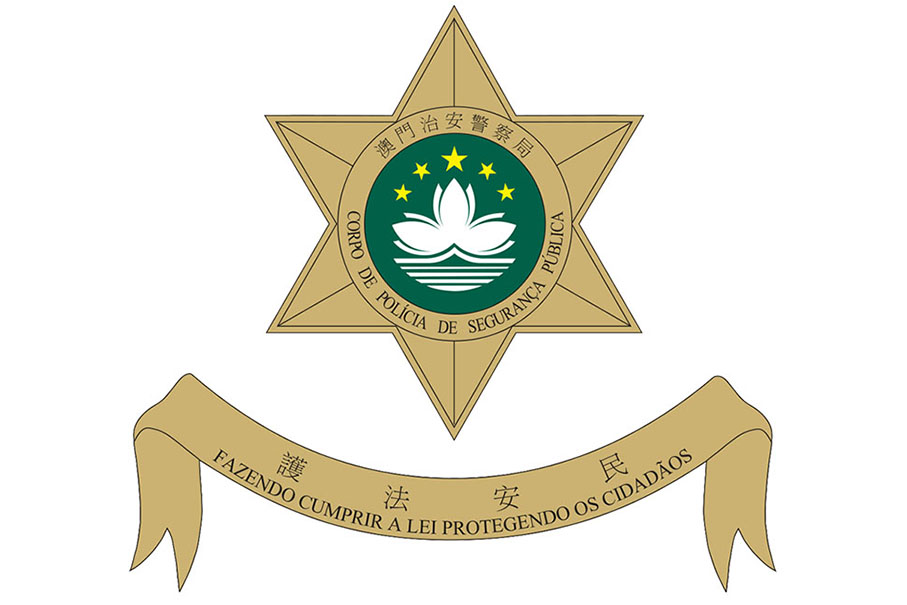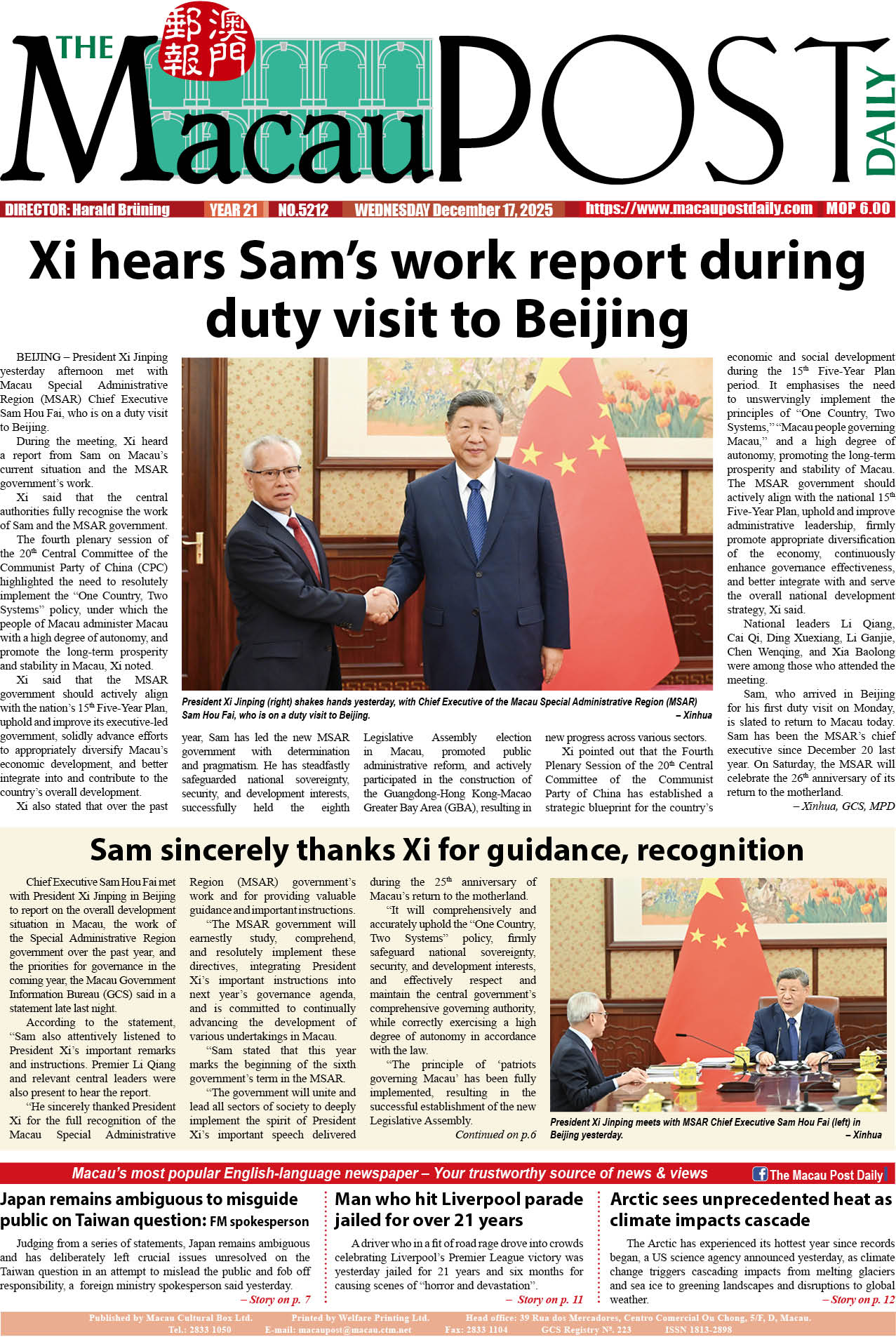A fact-finding visit to Xi’an, one of China’s Four Great Ancient Capitals (alongside Beijing, Nanjing and Luoyang) by an 18-member Portuguese- and English-language media delegation between Friday night and Sunday afternoon, of which I had the honour and pleasure to join, has reaffirmed my long-held view that the city of 13 million residents is one of the world’s prime examples of a site where antiquity and modernity meet in a strikingly congruent manner
The visit was splendidly organised by the Macau-based Commissioner’s Office of the Foreign Affairs Office. It was the second part of a two-city tour which started with a visit to Xiong’an New Area near Beijing on Thursday.
We travelled from Xiong’an to Xi’an by one of the nation’s globally admired high-speed trains at a velocity often exceeding 300 km/h. As I am one of those travellers who seem to go into starvation mode soon after the start of the journey, our delegation, appropriately enough, ordered dinner that was promptly – and inexpensively – delivered to our train at one of its various stops during the over 1,000-km-long ride. Moreover, I joined several of my fellow delegates to enjoy Costa Coffee in the train’s restaurant bar. High-speed train travel in the Chinese mainland is a tourist attraction per se. It’s an experience you shouldn’t miss.
This was my second trip to Xi’an, which I had visited as a member of a Macau media delegation over three decades ago.
Needless to say, Xi’an has changed tremendously since my last visit. As any other Chinese city, county and village it has undergone a rapid modernisation drive since the launch of the country’s reform and open-door development drive in 1978.
However, Xi’an has NOT changed beyond recognition, as its urban planners have been able to harmonise the city’s heritage preservation with its modernisation endeavour. Of course, this requires – as we can also see in Macau – a fair amount of situational awareness and cultural sensitivity. The aim of maintaining harmony in urban development should be understood as an ongoing process that requires continual evaluation and follow-up adjustments.
Li Anjun, the deputy director-general of the Foreign Affairs Office of the Shaanxi Provincial People’s Government (Xi’an is the capital city of Shaanxi, one of the foremost sources of Chinese civilisation), highlighted Xi’an’s ancient heritage and incessant modernisation effort in a speech during a dinner hosted by his office in our honour. He also underlined Xi’an’s crucial role in the Belt and Road Initiative (BRI) overseen by President Xi Jinping.
Both Xi’an and Macau are integral parts of the initiative – Xi’an by land, Macau by sea.
For me, due to my academic background in political economy, our visit to the China-Europe Freight Train (Xian) Assembly Centre was a highlight of the visit.
A recent article by Xinhua News Agency points out that Xi’an… has become a key hub of the BRI and the China-Europe freight train service. As the starting point of the ancient Silk Road, Xi’an has become a vital node linking Asia and Europe.”
Despite its location in the nation’s heartland, Xinhua underlined, Xi’an has become a critical assembly centre: “In just 10 years since the Xi’an route was launched in 2013, the number of trains operated by the city has grown significantly, from 46 in the inaugural year to over 5,300 in 2023.”
That’s what I would call tangible progress.
Currently, Xian operates 18 regular international freight train routes, including destinations in Almaty in Kazakhstan, Tashkent in Uzbekistan and Hamburg in Germany, according to Xinhua.
Officials at the colossal freight train station told us that with a designated annual container throughput of 5.4 million TEUs and a capacity of 66 million tonnes, the station ranks among the world’s first-class inland ports, i.e., a facility located away from the coast that serves as a freight transportation hub.
Xi’an’s pivotal role in fostering merchandise trade between China and Europe cannot be exaggerated, as it is vital to both sides. Within this context, I can only deplore the recent decision by the European Union to impose punitive tariffs on electric vehicle (EV) imports from China. Brussels’ crackbrained decision flies in the face of the – supposedly – global commitment to promoting environmentally-friendly products, EVs in particular.
Our visit to the Museum of Terracotta Warriors and Horses is a must for not only any first-time visitor to Xi’an. I found it as amazing this time as on my first visit as a news correspondent in 1991. Referred to as the 8th Wonder of the World, the necropolis dates back to 210-209 B.C.E. The Terracotta Army is a collection of terracotta sculptures depicting the armies of Qin Shihuang, the first emperor of China. The figures were buried with the emperor with the aim of protecting him in his afterlife. They were discovered by farmers in 1974.
We were also given the opportunity to watch “The Resurrected Legion” play – a 6-episode historical documentary about the terracotta warriors and their emperor at a purpose-built, multi-stage theatre. The soul-stirring performance by nearly four dozen actors and hundreds of extras – all of them martial arts students – left some of us shedding some tears.
And we even gained entry to paradise, well, a heritage theme park called “Tang Paradise” which, as its name suggests, offers visitors a bucolic display of the Tang Dynasty (618-907). The park, which opened in 2011, is a modern reconstruction of an ancient site – another example where antiquity meets modernity in Xi’an. It includes a host of fine-dining restaurants. Germany’s then chancellor, Angela Merkel, celebrated her 56th birthday at the park during an official visit to China in 2010. During her visit, Merkel was visibly delighted by the fact that German specialists were involved in efforts to preserve the colourful drawings that adorn the terracotta figures.
We also visited the Xi’an National Archives of Publications and Culture (NAPC), which opened in 2022, based on a decision by the Central Committee of the Communist Party of China (CPC) under General Secretary Xi. The NAPC headquartered in Beijing includes three branches – Xi’an, Hangzhou and Guangzhou.
According to the CPC Central Committee’s bimonthly magazine Qiushi (“Seeking Truth”) last year, “the NAPC represents a foundational project for China’s development as a great civilisation and a landmark cultural initiative that will benefit generations to come.”
Senior officials of its Xi’an branch gave us a detailed tour of the custom-made edifice, which uses state-of-the-art technology to preserve the documents catalogued and stored there.
As I am a passionate admirer of libraries and bookshops, wherever they are, I felt at home in the sprawling building erected close to 1,500-metre-high lush mountains.
Our lightning visit to the two starkly different cities has reaffirmed my belief that China, as the world’s most ancient nation in existence, is on the right path towards its future, without neglecting its millennia-old history. As exemplified by Xi’an, antiquity and modernity should be seen as different aspects of the same reality. While history can’t repeat itself, for the obvious reason that past, present and future can never be exactly the same because of the ever-changing conditions of our existence, we should, however, learn from it, namely by studying humanity’s plenty of successes achieved and scores of failures suffered over tens of thousands of years. The more we know about the past, the better we will be able to tackle the present and prepare ourselves for the future. What matters most, of course, is the present. I was happy to see during our trip that despite all the tumultuous challenges that our battered world is facing right now, present-day Chinese are enjoying their best living conditions ever. I am upbeat about their future.
– Harald Brüning
P.S. This is the second part of my editorial about last week’s trip to Xiong’an and Xi’an. The first part appeared on Monday.

Li Anjun, deputy director-general of the Foreign Affairs Office of Shaanxi Provincial People’s Government (9th from left), poses with members of the Macau Portuguese- and English-language media delegation and other mainland officials including Macau-based Foreign Affairs Ministry’s Commissioner’s Office senior official Gao Yuan (10th from left) and the delegation’s team leader Harald Brüning (8th from left), director of The Macau Post Daily, at the Tang Paradise theme park in Xi’an on Saturday. – Photos: Maria Cheang Ut Ment

Li Anjun (left), deputy director-general of the Foreign Affairs Office of Shaanxi Provincial People’s Government, standing next to an interpreter, addresses Macau’s Portuguese- and English-language media delegation during a welcome dinner in Xi’an on Saturday.







